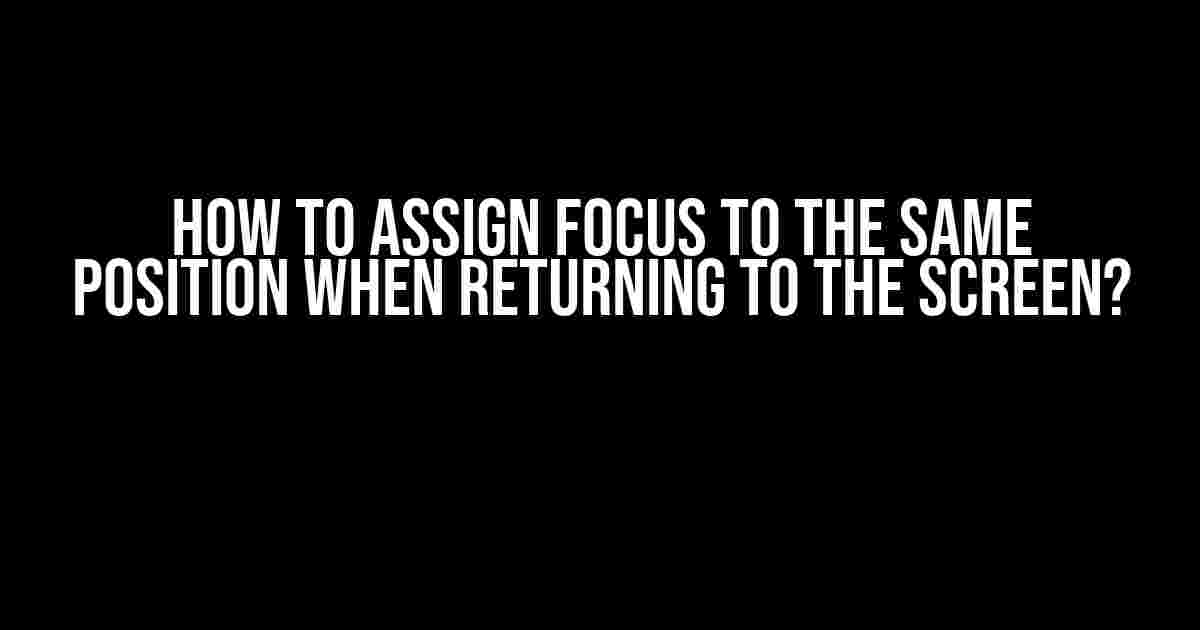Have you ever experienced the frustration of losing focus on a specific element when navigating back to a previously visited screen or webpage? It’s like retracing your steps, only to find that the spotlight has shifted, leaving you searching for the exact spot where you left off. Well, worry no more! In this article, we’ll delve into the world of HTML, CSS, and JavaScript to explore the solution to this common problem. So, buckle up and get ready to master the art of assigning focus to the same position when returning to the screen!
Understanding the Problem
Before we dive into the solution, let’s take a step back to understand the issue at hand. When you navigate away from a screen or webpage, the focus is lost, and when you return, the browser or application doesn’t remember the previous focus position. This can be particularly problematic in scenarios like:
- Filling out long forms, where you might need to revisit previous fields.
- Browsing through a list of items, where you want to resume from where you left off.
- Using assistive technologies, where focus management is crucial for accessibility.
Solution Overview
To assign focus to the same position when returning to the screen, we’ll employ a combination of HTML, CSS, and JavaScript techniques. Our approach will involve:
- Adding a unique identifier to the focusable element.
- Storing the identifier in local storage or a cookie when the element loses focus.
- Retrieving the stored identifier when the user returns to the screen.
- Using JavaScript to focus the element with the matching identifier.
Step-by-Step Implementation
HTML
Add a unique identifier to the focusable element using the `id` attribute. For example:
<input id="myInput" type="text" />
This could be a form field, a link, or any other focusable element.
CSS
No additional CSS is required for this solution. However, you can use CSS to enhance the visual appearance of the focused element, if desired.
JavaScript
Create a JavaScript function to store the identifier of the focused element in local storage or a cookie when the element loses focus. You can use the `addEventListener` method to attach an event listener to the `blur` event:
<script>
const inputField = document.getElementById('myInput');
inputField.addEventListener('blur', function() {
localStorage.setItem('focusedElement', inputField.id);
});
</script>
In this example, we’re using local storage to store the identifier. You can replace `localStorage` with a cookie or any other storage mechanism that suits your needs.
Retrieving and Focusing the Element
When the user returns to the screen, retrieve the stored identifier and use JavaScript to focus the element with the matching identifier:
<script>
const focusedElementId = localStorage.getItem('focusedElement');
if (focusedElementId) {
const focusedElement = document.getElementById(focusedElementId);
focusedElement.focus();
}
</script>
This code retrieves the stored identifier, gets a reference to the element with the matching `id`, and calls the `focus()` method to assign focus to the element.
Putting it All Together
Here’s the complete code example:
<input id="myInput" type="text" />
<script>
const inputField = document.getElementById('myInput');
inputField.addEventListener('blur', function() {
localStorage.setItem('focusedElement', inputField.id);
});
const focusedElementId = localStorage.getItem('focusedElement');
if (focusedElementId) {
const focusedElement = document.getElementById(focusedElementId);
focusedElement.focus();
}
</script>
Browser Support
This solution is widely supported across modern browsers, including:
| Browser | Version |
|---|---|
| Google Chrome | 58+ |
| Mozilla Firefox | 54+ |
| Microsoft Edge | 15+ |
| Safari | 11+ |
Accessibility Considerations
When implementing this solution, it’s essential to consider accessibility guidelines to ensure that the focused element is accessible to users with disabilities. Some key considerations include:
- Providing a clear visual indication of the focused element.
- Ensuring that the focused element is reachable using assistive technologies.
- Providing alternative text or descriptions for users who rely on screen readers.
Conclusion
Assigning focus to the same position when returning to the screen is a critical aspect of user experience. By following the steps outlined in this article, you can create a seamless browsing experience for your users. Remember to test your implementation across different browsers and devices to ensure that it works as intended. With a little creativity and some clever coding, you can make the web a more user-friendly place, one focused element at a time!
Frequently Asked Question
Mastering the art of assigning focus to the same position when returning to the screen can be a game-changer for your user experience. Here are some FAQs to get you started!
What is the purpose of assigning focus to the same position when returning to the screen?
Assigning focus to the same position when returning to the screen ensures a seamless user experience by maintaining the user’s attention on the same element or field where they left off. This is particularly important for accessibility, as it helps users with disabilities navigate your application more easily.
How do I assign focus to the same position when returning to the screen in a single-page application?
In a single-page application, you can use JavaScript to store the current focus position when the user navigates away from the screen and then restore it when they return. You can use libraries like jQuery to achieve this by saving the focused element’s ID or class and then using that information to set the focus back to the same element on return.
Can I use HTML5’s autofocus attribute to assign focus to the same position when returning to the screen?
While HTML5’s autofocus attribute can be used to set the initial focus on a specific element when the page loads, it’s not suitable for assigning focus to the same position when returning to the screen. Autofocus only works on page load, and it doesn’t persist when the user navigates away and returns to the page.
How do I handle cases where the focused element is dynamically generated or removed?
When dealing with dynamically generated or removed elements, it’s essential to update your focus management logic to account for these changes. You can use techniques like event listeners or DOM mutation observers to detect changes to the DOM and adjust the focus accordingly. This ensures that the focus is maintained even when the underlying HTML structure changes.
Are there any accessibility considerations I should keep in mind when assigning focus to the same position when returning to the screen?
Yes, definitely! When assigning focus to the same position, make sure you provide an audible or visual indication of the focused element, especially for users with visual or hearing impairments. Additionally, consider providing a mechanism for users to move the focus to a different element if needed, such as using the keyboard navigation or screen reader.




